Alone in the Dark Creator’s New Survival Horror, 2Dark
- Updated: 22nd Aug, 2014
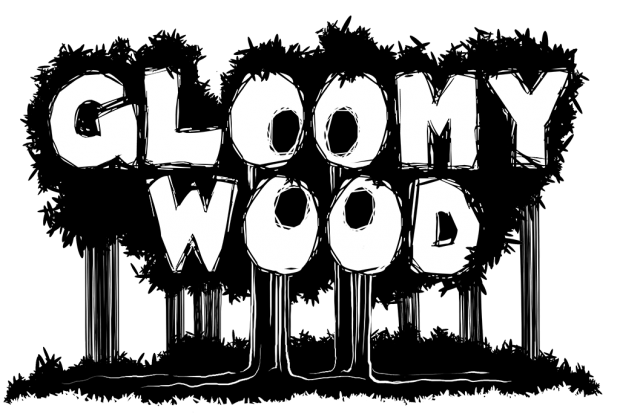
Huddled around a tiny table on an empty French gamescom booth that none of us owned, I spent 40 minutes talking with Frederick Raynal and Thierry Platon, co-founders of Gloomywood. Raynal doesn’t know this, but playing his 1992 game Alone In The Dark was a seminal moment in my childhood gaming experience.
Way back in 1992, I fired up our exciting new game, eyes gleaming brightly at the scene-setting opening sequence as Edward Carnby drove up to the mansion and ascended the stairs to the attic. With the atmosphere suitably creepy, I walked Carnby slowly around the room, cautiously exploring the chests and notes left lying on tables. Moments later, I nearly shat myself as the monster-dog-thing burst through the window with an ear-splitting clatter and killed me. I ran away from the computer and refused play another survival horror game for 22 years.
For some reason, I didn’t mention this during our talk.
Raynal and Platon have been in video games development for over 25 years apiece and had reached that point in their careers where they spent a lot of time on the indie game dev conference circuit. “We were speaking about these good old times,” said Raynal, “When games were made a little bit differently with different goals, with different wishes, and so I had the idea of this survival horror.”
“We decided to set up a new company just with both of us and our wives because his wife [Sophie-Ann Bled] is in the financial system, and my wife [Yaél Barroz] is an artist. She did the backgrounds for Alone in the Dark, and Little Big Adventure.”
That company is Gloomywood and they’ve recently released a teaser trailer for their upcoming survival horror, 2Dark. It’s pre-alpha demo footage and a far cry from their final vision, but gets across what they’re planning to do.
“I wanted, and Thierry wanted, to make games to find the mood, the spirit of the things we had 15 years ago when we made games, when everybody was [in] passionate, small teams. Alone In The Dark, for example, was the triple-A of its time in ’92 but we were seven [people]. For Little Big Adventure, triple-A two years later, 15 people.
“[2Dark] is a retro-style game with retro graphics with a retro team and retro gameplay but with nowadays techniques and nowadays communication and a nowadays system. All the voxel rendering, 2D backgrounds, everything will be done with shaders, complex lighting. We’ll keep the pixel art look but with nowadays techniques that will add a lot of small details. It’s all GPU raycasting of the voxel system with a very new and special – it’s not in the trailer yet because it’s not yet finished – but we have a new way of animating characters which will give the smooth sprite, soft sprite. Something that will be very, very different.”
In 2Dark you play as a man who, for his own personal reasons, is hunting down serial killers that kidnap children. At a very superficial level, you can treat the game as a sort of twin-stick shooter, albeit one with survival horror levels of ammunition. You’ll be entering the killers’ lairs, searching for keys to unlock doors, evading traps and facing down guards.
“Every time we tried to find something very horrible, it already exists.” said Raynal. The killer glimpsed in the trailer above is called Delicatessen Lewis, and he’s partly inspired by a man named Geoffrey Portway, nicknamed “Fat Longpig”, who planned to butcher and eat a child.“We were trying to find some characteristics useful for the game and the gameplay. We’d say ‘Oh, this is completely crazy. Nobody would… oh. Yes. One did that for real.’
“So when you play the game if you are an adult, you will realise that the things that we can read and not directly see in the game – you see a game like this and you see children cut in half, on the ground. Okay, it’s 12 voxels here and 12 voxels here, but it’s just horrible.”
“Everything is suggestion, in fact,” said Platon “Even the story. You have not much dialogue, not many cutscenes. You have things you find and you can imagine what these guy do, but you don’t know exactly what these guys do. But you find some cooking recipe with bizarre things. You find a little piece of children somewhere. And ‘Oh, is it cannibals?’ That’s the way we told the story.”
“It was like Alone in the Dark,” continued Raynal “If you replay Alone in the Dark, you are alone. There are no other characters, no dialogue at all. The background story of the house, was just in books so if you read them, it’s even more frightening because you imagine whatever you want. But on the screen this time it was 12 polygons and it was not very frightening at all.” 12-year-old me would disagree vehemently at this point. Current me kept her mouth shut.
As well as taking down the serial killers, you have to save the children. 2Dark is designed to be replayable, much like the mission structure of Dishonored. Sure, you can charge in guns blazing and kill all the guards, but you’ll take some damage and some of the kids might get hurt. To get the top scores, you don’t want to hurt anyone, including yourself.
This will get tricky for many reasons. For a start, kids don’t always do what they’re told. Stop at the edge of a pit in a dark room with four children in tow and one of them could easily fall in. Or tell a bunch of toddlers to stay quiet in a dark room and one of them might start crying because a guard walks past. This is what kids do. Much of the game is about managing in the darkness – you’ll also have to keep your light sources filled with fuel, though you do also have visual cues to help with the audio positioning.
“Everything that is not in direct light is completely black but you can see those blue circles,” said Raynal. “They are the waveform of the sounds. So you can very precisely locate where the sounds are from – it’s like a human. Close your eyes in a room and every little noise you can say, this is here, this is here. So I decided to show the real location and the size depending on the volume of the sound but it works both ways. You also make sounds and the enemy, the animals and everything hears you in the same way and locates you in the same way.”
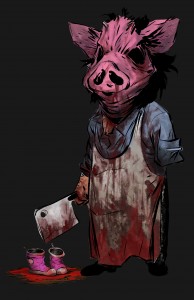 Platon continues the story. “In the beginning the children follow you. And the first level, they follow you because you are the saviour. Every killer has his own lair with their own environments regarding their personality. During the story, the progression, the children can completely change. At the beginning, they’re easy to save, they want to follow you. And after [a while] you begin to find children who don’t want to follow you. They love their serial killer. They are so indoctrinated by this killer that they just want to kill you. So you have to save children that want to hurt you.”
Platon continues the story. “In the beginning the children follow you. And the first level, they follow you because you are the saviour. Every killer has his own lair with their own environments regarding their personality. During the story, the progression, the children can completely change. At the beginning, they’re easy to save, they want to follow you. And after [a while] you begin to find children who don’t want to follow you. They love their serial killer. They are so indoctrinated by this killer that they just want to kill you. So you have to save children that want to hurt you.”
Having children as guards also brings up other complications. “We feel responsible somewhere,” said Raynal, “even if it’s survival horror, even if it’s very evil guys that you like to kill. It’s not a killer game where you say you are right about everything, kill everybody and you just win.”
“And when you are in the dark,” said Raynal, “with the visual sounds, you can see blue circles coming towards you and you don’t know what it is. Don’t shoot in the dark because it could be a kid trying to join you. So you think all the time ‘I need to shoot.’ No! Don’t shoot at kids.”
The guards will continue on their pitch-black patrol routes until disturbed by you or a stray child. I suggested that you could use the children as a distraction.
“Yes” said Raynal, “but that is something that is still in question. Because yes, as you can drop kids – especially at the end when they don’t want to follow you, you have to grab them, lock them somewhere, to be sure that you can bring them to the exit at the end. But as you can hold them, you can also throw them to send them into a cage. But then you can send them in a trap or to disturb a monster. But…
“It’s a consequence. We didn’t want this behaviour but it works in the game.”
“But you’re supposed to save them all,” I offered.
“Yes, but okay. Let’s say the army or something. Maybe sometimes one soldier needs to sacrifice himself. So, in the game I’m fine with sacrifice of yourself. You need to sacrifice yourself to make something? Okay, it’s yourself. Sacrificing kids – say ‘but I need to sacrifice one to save the other’ that’s something that works in the game right now but we are still questioning. We still need to test more reactions of people because we don’t want them to say ‘Haha, that’s very good, it’s a game you can throw kids to traps.’ No! That’s exactly what we don’t want.”
Platon said “I spent my time in game design conferences saying ‘Guys, you have to take care of the value in your games. That’s important, everybody in cinema does it. Try to do it when you think about your game.’ This is the main thing. At least I have to do it for myself.
 So at the beginning it was like, ‘Okay, there are good kids [that give you] many points and bad kids with small [fewer] points.’ No. They’re all the same kids. So we try to take care of what we say in this game.”
So at the beginning it was like, ‘Okay, there are good kids [that give you] many points and bad kids with small [fewer] points.’ No. They’re all the same kids. So we try to take care of what we say in this game.”
Raynal continued “A baseball bat was a kind of weapon to hit something like a hammer. We changed it recently. Okay, it just a consequence; you can hit with your baseball bat, hit the soldier and serial killers, but as it worked just like this.” Here he mimed a swinging action. “You can also hit kids with it. And something we realised is that, imagine somebody would say ‘Haha, this is so cooool, you can kill the kids, blood spurts from the kids.’
“Imagine YouTube videos with a system like that,” said Platon. “Okay, forget it. Not the children. Or you know, just a video where the guy saves every child, goes to the exit and just kills them! We don’t want that.”

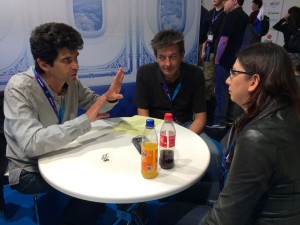
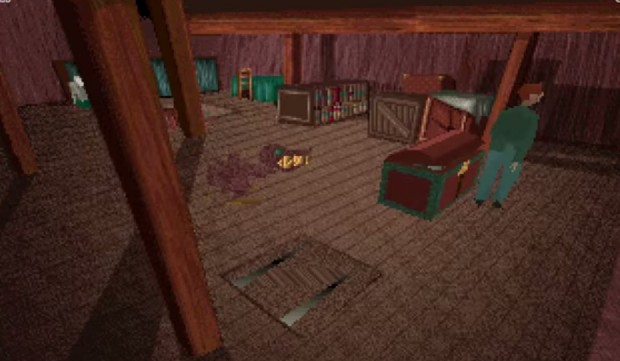
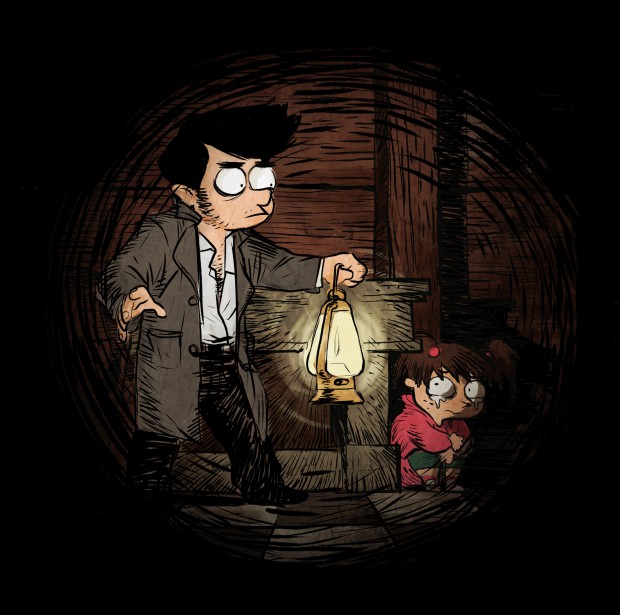
Pingback: Around the Internet | Gaming News
Pingback: In Other News: Trials Fusion, 2Dark - Expansive